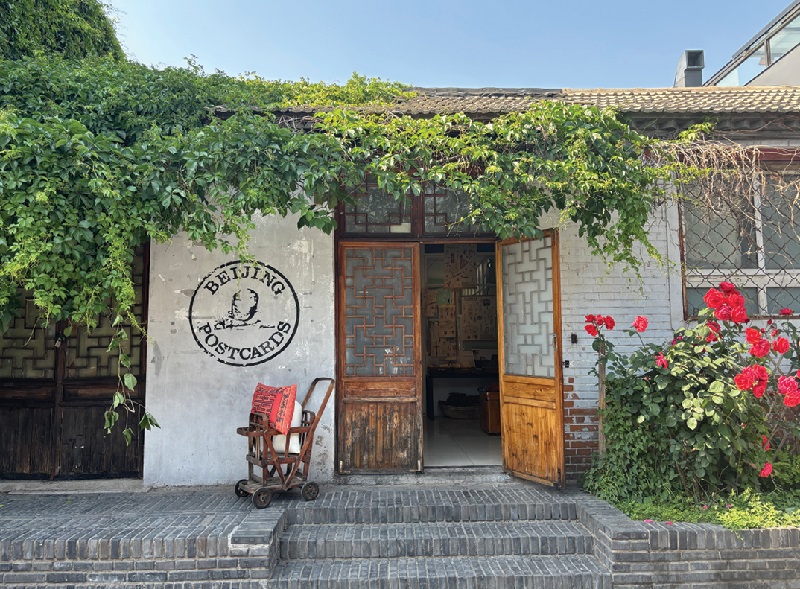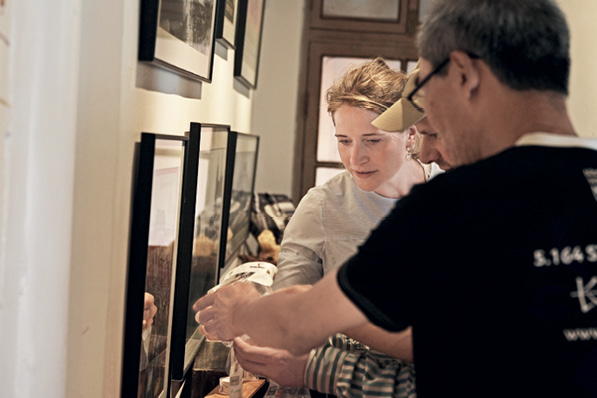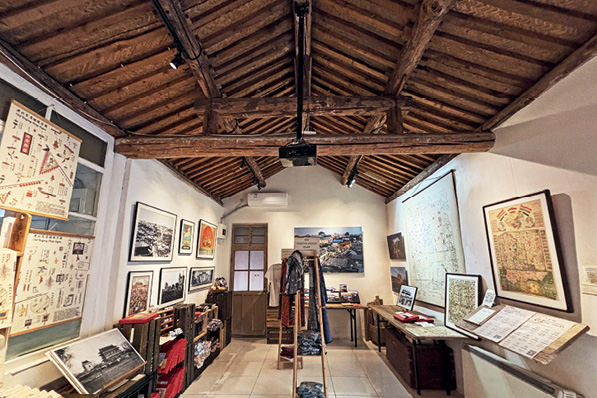A Danish fan of Chinese culture has found an innovative way of sharing the Chinese capital’s history with more people.

Beijing Postcards, an unusual store in Yangmeizhu Byway, Beijing’s Dashilar area, is a gallery of the capital’s history.
A visit to the bustling Qianmen Street in downtown Beijing might lead you to a quaint small shop in the Yangmeizhu Byway in the Dashilar area, a famous ancient commercial zone that is a prime tourist attraction today. Unlike other modern cafes, restaurants, and cultural shops in the street, the shop, Beijing Postcards, started by the Danish Lars Ulrik Thom, sells cultural and creative products with historical elements. As a gallery on Beijing’s history, it has become a communication space connecting residents and tourists with the memory of old Beijing.

Visitors learn the history of Beijing through the old photos in the shop.
A Guide to History
In 1996, Thom traveled by train from Mongolia to China.When he arrived in Beijing, he was struck by the vitality he saw: “During the winter, not much was really happening in Mongolia, but the moment you got to China, things were very different. When you got off the train, there were people everywhere, you could see buildings absolutely everywhere. What I saw was a thriving city,” the Danish visitor said.
Having a strong interest in Chinese history, Thom decided to stay in Beijing and delve into its history and culture. “It’s not so easy to understand the history of Beijing as a foreigner, not if you compare it with that of Denmark. The whole city of Beijing has been rebuilt throughout history. To some extent, you almost cannot imagine that it’s the same city as it was 20 years ago. The place is undergoing a very fast change and at the same time facing new challenges.”
Thom began to collect information from public spaces, such as scenic spots, museums, and archives. He also dived in the hutongs, the old alleys with traditional one-storied houses with a courtyard, to obtain the oral history of local people. The residents recalled their daily lives from their old photos, which helped Thom understand how historical changes affected people’s daily life.
To introduce the history of Beijing to more people in a new form, Thom and his friends founded Beijing Postcards, selling postcards, calendars, and puzzles from the old photos and maps they collected. In addition, based on his research on Beijing’s history, he organizes theme activities to share old anecdotes and his experience.
The logo of Beijing Postcards, created by Thom’s former partner, features a little boy writing diligently. “It is exactly what we are doing, diligently introducing the history of Beijing to people from across the world,” Thom told China Today.
Thom set up shop in Dashilar because he thinks it is the first stop to learn about Beijing. “In the past, this is where people would settle after arriving in Beijing. And during the Qing Dynasty (1644-1911), it emerged as a commercial hub. Just outside the inner city wall, you would have all kinds of businesses. All of it makes this place super fascinating,” he explained.
The renovation of Dashilar is a typical case of protecting and revitalizing historical blocks in Beijing. Thom attributes the success to not just the fact that the shopkeepers in the street can now earn more money but to the balance between the residents, shopkeepers, businessmen, and tourists to fit the environment and coexist.
At present, Thom and his team are working on a book about the history of Dashilar. He wants to tell more people about the vitality of this area in different periods. In addition to learning about Chinese history from the famous Palace Museum, readers can also learn about Beijing’s common culture from an area not far from the museum.

Inside Beijing Postcards.
Maps as a Guide to History
Maps provide another way for Thom to understand Beijing. He has collected many maps created by artists from different countries. He was impressed by a reprint of the famous painting Qianlong Emperor’s Southern Inspection Tour. Emperor Qianlong, who ruled from 1736 to 1795, went on six inspection tours of southern China during his long reign. The Qianlong Emperor’s Southern Inspection Tour was a series of 12 oversized scroll paintings commissioned to document the first tour in 1751.
“The paintings are really long and I think it must have taken years to paint them. There are many minute details about the hutongs,” Thom said. He was surprised to discover on the map the names of famous cigarette brands of that time. It is also a record of the street scenery in the past, showing the contrast with its current appearance.
Thom found another intricate detail. On a cartoon map drawn by an American in 1936, there was a cannon on a position marked with the number 67. Thom’s colleague went to the Beijing Municipal Archives to research it and found that such cannons were kept near Qianmen and Deshengmen, Beijing’s two city gates in the south and north, respectively, and fired at noon so that residents would know what time it was.
The Bell and Drum Towers are two brick and wood ancient structures located on the north end of Beijing’s central axis. The drums and bell would be sounded to tell the time and were regarded as the time announcement center of the city. After Emperor Puyi, the last emperor in Chinese history, abdicated in 1912, the inner city of Beijing became a public place, and the Bell and Drum Towers announced the time only when the city gates closed at night. The noon cannons were installed in 1924 and people could tally their mechanical watches according to the gunshots. “A very small detail actually tells a very interesting story about the evolution of modern Beijing,” Thom said.
He still gets old photos and maps from his friends. Recently, he obtained two old photos taken by Italian-British photographer Felice Beato during the Second Opium War (1856-1860). One is the picture of the Summer Palace, the Qing imperial garden, before its destruction, the other is of the Temple of Heaven, a complex of religious buildings where the emperors prayed and offered sacrifices, before it opened to the public.
Through his interactions with many foreigners in Beijing, Thom found that many of them are keenly watching the development of Beijing. “Beijing is the capital of China. What happens here matters to the world. It is necessary to keep paying attention to China,” he said.
He also found that many foreigners who come to China are pleasantly surprised by the relaxed atmosphere in Beijing, which is a different impression from that created by some foreign media. He thinks Westerners need to learn more about Chinese history to better understand China.
Due to his desire to understand Chinese culture from a historical perspective, Thom has chosen to stay in China for nearly 30 years. Other historical cities, such as Pingyao in Shanxi, which used to be an economic hub, and Xi’an in Shaanxi, a former capital in ancient China, have also left a deep impression on him. In these cities, he enjoyed learning the local history from the preserved ancient buildings.
Why is studying history so important? Thom has his explanation: “Studying history is not so much about remembering that the last Chinese emperor abdicated in 1912. It’s about behavioral patterns and all kinds of things. It’s important to look at something from another country’s perspective. We cannot do that without history, or understand why some countries reacted in a certain way.”